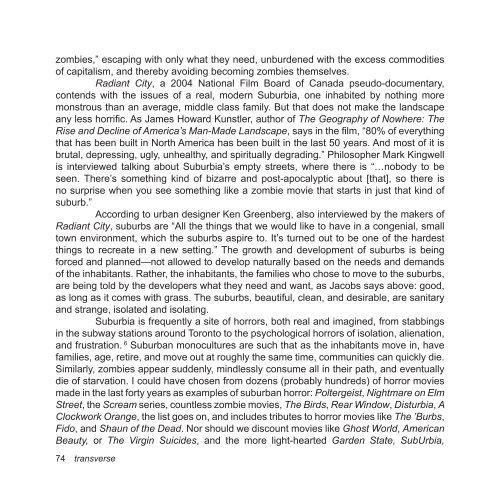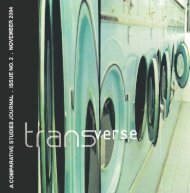Untitled - Centre for Comparative Literature - University of Toronto
Untitled - Centre for Comparative Literature - University of Toronto
Untitled - Centre for Comparative Literature - University of Toronto
Create successful ePaper yourself
Turn your PDF publications into a flip-book with our unique Google optimized e-Paper software.
zombies,” escaping with only what they need, unburdened with the excess commodities<br />
<strong>of</strong> capitalism, and thereby avoiding becoming zombies themselves.<br />
Radiant City, a 2004 National Film Board <strong>of</strong> Canada pseudo-documentary,<br />
contends with the issues <strong>of</strong> a real, modern Suburbia, one inhabited by nothing more<br />
monstrous than an average, middle class family. But that does not make the landscape<br />
any less horrifi c. As James Howard Kunstler, author <strong>of</strong> The Geography <strong>of</strong> Nowhere: The<br />
Rise and Decline <strong>of</strong> America’s Man-Made Landscape, says in the fi lm, “80% <strong>of</strong> everything<br />
that has been built in North America has been built in the last 50 years. And most <strong>of</strong> it is<br />
brutal, depressing, ugly, unhealthy, and spiritually degrading.” Philosopher Mark Kingwell<br />
is interviewed talking about Suburbia’s empty streets, where there is “…nobody to be<br />
seen. There’s something kind <strong>of</strong> bizarre and post-apocalyptic about [that], so there is<br />
no surprise when you see something like a zombie movie that starts in just that kind <strong>of</strong><br />
suburb.”<br />
According to urban designer Ken Greenberg, also interviewed by the makers <strong>of</strong><br />
Radiant City, suburbs are “All the things that we would like to have in a congenial, small<br />
town environment, which the suburbs aspire to. It’s turned out to be one <strong>of</strong> the hardest<br />
things to recreate in a new setting.” The growth and development <strong>of</strong> suburbs is being<br />
<strong>for</strong>ced and planned—not allowed to develop naturally based on the needs and demands<br />
<strong>of</strong> the inhabitants. Rather, the inhabitants, the families who chose to move to the suburbs,<br />
are being told by the developers what they need and want, as Jacobs says above: good,<br />
as long as it comes with grass. The suburbs, beautiful, clean, and desirable, are sanitary<br />
and strange, isolated and isolating.<br />
Suburbia is frequently a site <strong>of</strong> horrors, both real and imagined, from stabbings<br />
in the subway stations around <strong>Toronto</strong> to the psychological horrors <strong>of</strong> isolation, alienation,<br />
and frustration. 6 Suburban monocultures are such that as the inhabitants move in, have<br />
families, age, retire, and move out at roughly the same time, communities can quickly die.<br />
Similarly, zombies appear suddenly, mindlessly consume all in their path, and eventually<br />
die <strong>of</strong> starvation. I could have chosen from dozens (probably hundreds) <strong>of</strong> horror movies<br />
made in the last <strong>for</strong>ty years as examples <strong>of</strong> suburban horror: Poltergeist, Nightmare on Elm<br />
Street, the Scream series, countless zombie movies, The Birds, Rear Window, Disturbia, A<br />
Clockwork Orange, the list goes on, and includes tributes to horror movies like The ’Burbs,<br />
Fido, and Shaun <strong>of</strong> the Dead. Nor should we discount movies like Ghost World, American<br />
Beauty, or The Virgin Suicides, and the more light-hearted Garden State, SubUrbia,<br />
74 transverse




